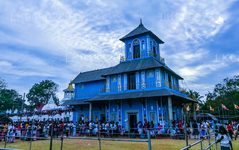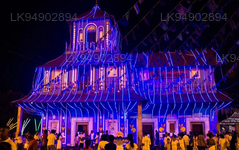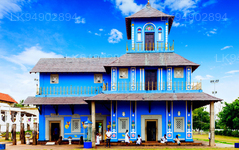
Kandy-stad
Kandy, een pittoreske stad in centraal Sri Lanka, staat bekend om zijn rijke culturele erfgoed, levendige festivals en schilderachtige schoonheid. Gelegen tussen weelderige heuvels, herbergt de stad de Tempel van de Tand, een UNESCO-werelderfgoed, en biedt een fascinerende mix van geschiedenis en natuurlijke pracht.
Maha Vishnu Devalaya
On to the North-West of the palace, in front of the “Natha Devale“ is the “Vishnu Devalya” popularly a the “Maha Devale”. This is one of the Hatara Devale in the Kandy, the other three being the Natha, Kataragama and Patini. These four Devalayas have a long association with the Royal Palace ( Maha Vasala) and the Temple of Tooth Relic (Sri Dalada Maligawa) and has been venerated by Buddhists and Hindus alike from the inception.
Different historical documents have called this deity and the Devale by different names. Robert Knox, the English Prisoner has called the deity in this devale “Aluth Nuwara Deiyo”. According to legend the “Aluth Nuwara Deviyo” was brought to Aluth Nuwara in Kegalle District from Devinuwara in Matara. This deity was called “Upulvan Deiyo” (deity with a colour of a lotus). Later this deity in Aluth Nuwara was known as “Vishnu”. The 15th century “Paravi Sandeshaya”, a poetical work describes the deity at Devinuwara, Matara as a destroyer of Asura. Thus it can believed that this same deity is also “Rama” of the great Indian Epic “Ramayana”. Interestingly “Ehelapola Varnanawa”, a poetical work done in the 19th century calls this shrine at Kandy, “The Rama Devale”. It is also interesting to note that this devale has had in possesion a cloth painting depicting the Battle of Rama and Rawana.
“According to Mahavansa, The great chronicle of Sri Lanka, It was “Upulvan Deiyo” thus Vishnu that was selected as the guardian to protect the land of Sri Lanka and Buddhism within it at the time of Buddha’s passing away.
“When the Guide of the World, having accomplished the salvation of the whole world and having reached the utmost stage of blissful rest, was lying on the bed of his nibbana; in the midst of the great assembly of gods, he, the great sage, the greatest of those who have speech, spoke to Sakka’ who stood there near him: `Vijaya, son of king Sihabahu, is come to Lanka from the country of Lala, together with seven hundred followers. In Lanka, O lord of gods, will my religion be established, therefore carefully protect him with his followers and Lanka.
When the lord of gods heard the words of the Buddha he from respect handed over the guardianship of Lanka to the god who is in colour like the lotus.
According to beliefs, Vishnu is a future Buddha after Natha. Therefore Vishnu always has had a high ranking within the deities worshipped by the Sri Lankans. During the Kandyan Era the the Kings “Abisheka Mangallaya” or the Coronation Ceremony was held at this Maha Devale.
The origin of Vishnu Devalya or the shrine of Vishnu is unclear. This is a long building with a storied sanctum at the end. In front the sanctum is a long hall called “dig-ge”. This hall is for dancers and who carry out puja for the deity. Today it is used by the devotees to pray. This building complex is entered through a two storeyed Vahalkada (entrance doorway), to an open hall with timber columns in the middle terrace, a beautifully carved stone flight of steps and the drumming hall. On the upper terrace is another small shrine, the God Dedimunda’s Shrine and a large Bo-tree.
Over het district Kandy
Het district Kandy ligt in de centrale provincie van Sri Lanka. Kandy, een van de zeven werelderfgoedlocaties in Sri Lanka, was ooit de thuisbasis van de Kandyaanse koningen van weleer in de 16e eeuw en een bron voor alle muziek, kunst, ambachten en cultuur in het land. Kandy ligt op ongeveer 129 km van Colombo en is genesteld in een heuvelachtig terrein en alle ogen worden getrokken naar het centrum van de stad, waar het Kandy-meer een charmant kenmerk vormt. Kandy behoudt een grote religieuze betekenis voor Sri Lanka, omdat in deze charmante stad de Dalada Maligawa of "Tempel van de Tand" zich bevindt, waarin de heilige tand van Boeddha goed bewaard wordt. De Koninklijke Botanische Tuin, Peradeniya, ligt ongeveer 5 km ten westen van het stadscentrum in Peradeniya en wordt jaarlijks door 1,2 miljoen mensen bezocht. Het is de grootste botanische tuin op het eiland. De Udawatta Kele (Udawatta-bos) is een beschermd heiligdom in het hart van de stad, net ten noorden van de Tempel van de Tand. Kandy is een stad met een Sinhalese meerderheid; er zijn aanzienlijke gemeenschappen die behoren tot andere etnische groepen, zoals Moren en Tamils. Kandy is, na Colombo, het centrum van de Sri Lankaanse economie. Veel grote bedrijven hebben grote vestigingen in Kandy en veel industrieën, waaronder textiel, meubels, informatietechnologie en sieraden, zijn hier te vinden. Veel landbouwonderzoekscentra bevinden zich in de stad. Het is tevens een bron van alle muziek, kunst, ambachten en cultuur van het land. Op ongeveer 129 km van Colombo ligt Kandy verscholen in een heuvelachtig gebied en alle ogen worden getrokken naar het centrum van de stad, waar het Kandymeer een charmant kenmerk vormt. Kandy heeft een grote religieuze betekenis voor Sri Lanka, omdat in deze charmante stad de Dalada Maligawa, oftewel Tempel van de Tand, is gevestigd, waar de heilige tand van Boeddha goed bewaard wordt.
Over de Centrale Provincie
De Centrale Provincie van Sri Lanka bestaat voornamelijk uit bergachtig terrein. De provincie heeft een oppervlakte van 5.674 km² en een bevolking van 2.421.148. Enkele belangrijke steden zijn Kandy, Gampola (24.730), Nuwara Eliya en Bandarawela. De bevolking is een mix van Singalezen, Tamils en Moren. Zowel de heuvelhoofdstad Kandy als de stad Nuwara Eliya, evenals Sri Pada, liggen in de Centrale Provincie. De provincie produceert een groot deel van de beroemde Ceylonthee, die in de jaren 1860 door de Britten werd geplant nadat een verwoestende ziekte alle koffieplantages in de provincie had vernietigd. De Centrale Provincie trekt veel toeristen, met heuvelstadjes zoals Kandy, Gampola, Hatton en Nuwara Eliya. De Tempeltand, of Dalada Maligawa, is de belangrijkste heilige plaats in de provincie Centrel. Het klimaat is koel en veel gebieden boven de 1500 meter hoogte hebben vaak koude nachten. De westelijke hellingen zijn erg nat, met op sommige plaatsen bijna 7000 mm regen per jaar. De oostelijke hellingen behoren tot de middeldroge zone, omdat ze alleen regen ontvangen van de noordoostelijke moesson. De temperaturen variëren van 24 °C in Kandy tot slechts 16 °C in Nuwara Eliya, dat 1889 m boven zeeniveau ligt. De hoogste bergen van Sri Lanka liggen in de Centrale Provincie. Het terrein is overwegend bergachtig, met diepe valleien die het doorsnijden. De twee belangrijkste berggebieden zijn het Centraal Massief en het Knuckles-gebergte ten oosten van Kandy.


























